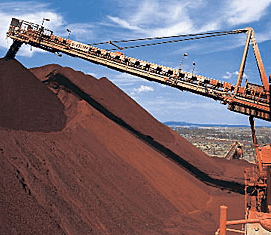
Earlier this month, Rio Tinto’s Chief Economist, Vivek Tulpule, told reporters that the firm believed that China’s economic growth would rebound and stay strong until 2020:
Rio Tinto expects economic growth in China to rise to at least 8 percent in 2013 and average 8-9 percent to 2015, a more bullish view than the global miner’s main rivals…
Rio Tinto, the world’s No.2 iron ore miner, sees Chinese growth picking up from below 8 percent this year as a new government in Beijing relaxes restrictions on real estate investment and pushes infrastructure spending, which will drive demand for steel and in turn iron ore, its chief economist said.
“On balance we’re seeing some green shoots and an expectation next year that the GDP growth rate will have an 8 in front of it”…
Rio is sticking to its view outlined earlier this year for Chinese growth to average 7-8 percent from 2015-2020 and slowing to 5-6 percent growth beyond 2020, but said it was likely to be a volatile path towards slower growth as the Chinese economy evolves from being investment driven to consumer driven…
By comparison, top global iron ore miner Vale now sees China’s economy growing at 6-7 percent a year over the rest of this decade. BHP Billiton sees China’s annual growth averaging 7-8 percent over the next decade.
Rio Tinto sees Chinese steel production peaking at 1 billion tons a year around 2030, slightly later than earlier forecasts for it to peak at that level around 2025…
Today, the head of Rio’s China operations, Ian Bauert, reportedly blasted the “impending doom camp” of China analysts, instead predicting that Chinese demand for Australian resources will remain strong for decades as its economy continued down the path of urbanisation. From The Australian:
Ian Bauert told the In The Zone conference in Perth today 690 million people, more than half of China’s population, now lived in cities and it was estimated the urban population would hit the 1 billion-mark by 2030.
The Shanghai-based executive’s comments are significant as Rio Tinto is the only big Australian miner that has not scaled back its iron ore expansion plans in the Pilbara in recent months as the price of the steelmaking ingredient fell.
Mr Bauert said Rio believed China’s rapid rate of urbanisation would drive resources demand for decades to come.
“Steel demand is intrinsically linked with urbanisation… The average urban resident in China consumes 10-15 times the average rural resident. And urbanisation tells a large part of the China demand story, not just for iron ore but across a range of commodities”…
“While we should not expect demand to grow at the blistering pace we have seen over the last decade, nevertheless growth in demand will still be substantial,” he said.
“A rough rule of thumb is that minerals demand in a developing economy by and large tends to move in line with GDP growth rates”.
“Projected growth rates of 7 to 8 per cent over the next few years, on a now sizable base, is still substantial”.
Clearly, commentators like Michael Pettis and Patrick Chovanec have different views. Even if the Chinese economy doesn’t experience a so-called “hard landing”, its economy must rebalance away from investment-led growth (i.e. building stuff) towards consumption-led growth, which is necessarily less commodity intensive. That is, China can grow just fine but Rio Tinto not benefit at all.
Rio’s bullish forecasts on the Chinese economy also seem to be at odds with the incoming Chinese premier’s plan to end “one-sided GDP growth”, which is expected to result in growth rates of around 7% annually to 2020.
Twitter: Leith van Onselen. Leith is the Chief Economist of Macro Investor, Australia’s independent investment newsletter covering trades, stocks, property and yield. Click for a free 21 day trial.

